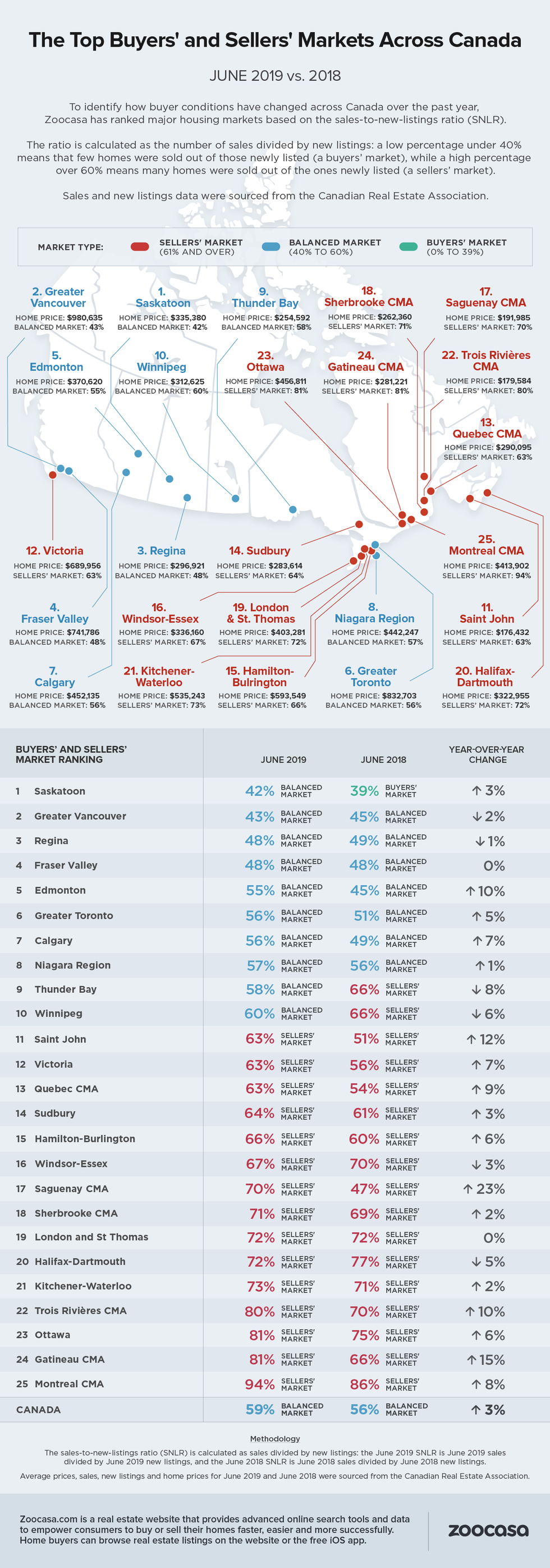Canadians looking to buy a home this year might want to wait out the market. According to a new infographic from Zoocasa, the majority of cities across the country are sellers’ markets.
The real estate listings site looked at June data from the Canadian Real Estate Association. Out of the 25 markets they analyzed, 15 were sellers’ markets and 10 were balanced. That means no cities were considered buyers’ markets last month.
READ: Toronto House Prices Are On The Rise As The Market Rebounds
This was determined using the sales-to-new-listings ratio, which measures competition in the housing market. The number of sales is divided by the number of new listings in a month to get this ratio. Percentages between 40 and 60 per cent are balanced, while anything above 60 is a sellers' market and below is a buyers' market.
“Overall, the Canadian real estate market is considered to be balanced, though it’s creeping closer to sellers’ territory,” Penelope Graham, Zoocasa’s managing editor, said. “The national sales-to-new-listings ratio (SNLR) hit 59 per cent last month, up from 56 per cent the year before.”
READ: Millennials Favour Partners With Property Prospects Over Good Looks: Survey
In June, hot sellers’ markets had an average home price of $500,000. This includes cities like Gatineau, Ottawa, Halifax, Victoria, and Saint John.
But Montreal had the hottest sellers’ market with an SNLR of 94 per cent. Homes sales rose by seven per cent year over year in June, while new listings only fell by -1.4 per cent.
READ: What Exactly Happens After An Offer Is Accepted?
“As a result, the average home price has surged by 6.3 per cent year over year to $413,902 – still considerably lower than in Canada’s other large urban markets,” Graham explained.
In comparison, Toronto has an average price of $832,703. Despite the fact that the city has a balanced market with an SNLR of 56 per cent, it’s moving closer to the sellers’ side. According to Zoocasa, sales have increased by 9.6 per cent, and new listings have fallen by -0.7 per cent, creating more competition and driving up prices.
READ: Montreal’s Luxury Real Estate Sales Skyrocket Compared To Toronto
Vancouver, on the other hand, has been softening. The West Coast city now has an SNLR of 43 per cent due to a drastic drop in sales (-15 per cent) and new listings (-10.6 per cent).
“A combination of provincial policies, the national mortgage stress test, and price fatigue effectively cooled the market,” Graham noted.
READ: Bank Of Canada Lowers Mortgage Rate For 1st Time In 3 Years
In addition to Toronto and Vancouver, other cities considered balanced include Winnipeg, Calgary, Edmonton, and Regina.
Check out Zoocasa’s full infographic below to see all the top sellers’ markets across Canada.






















